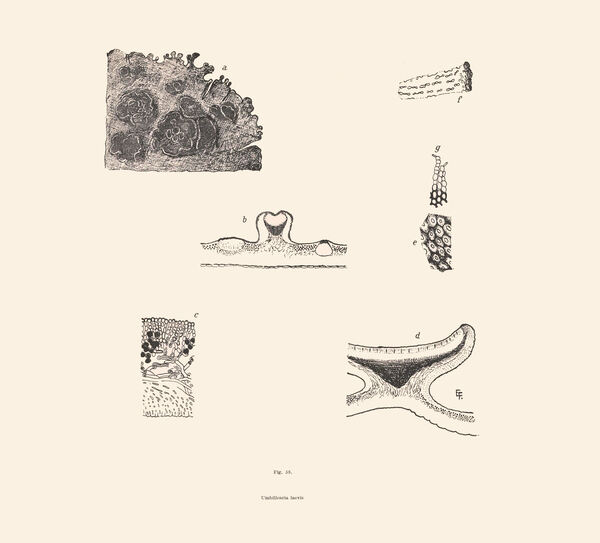Umbilicaria laevis (Schaer.) Frey
Hedwigia, 71: 17, 1931. Basionym: Gyrophora atropruinosa var. laevis Schaer. - Naturwiss. Anz., 1: 8, 1818.
Synonyms: Agyrophora laevis (Schaer.) Llano; Gyrophora laevis (Schaer.) Du Rietz
Distribution: N - TAA (Lich.Alpium 320: Narui & al. 1996), Lomb, Piem (Isocrono & al. 2004), VA (Borlandelli & al. 1996, Piervittori & Isocrono 1997, 1999, Piervittori & al. 2004).
Description: Thallus foliose-umbilicate, heteromerous, dorsiventral, polyphyllous, regular in outline, 3-4 cm wide, 0.1-0.2 mm thick, attached by a central holdfast. Outer lobes more or less adpressed, with a black, glossy margin, central lobes shorter and less ascending, with lacerated, deeply incised, undulating, curled margins. Upper surface greyish beige, darker towards margins, irregularly cracked, smooth or slightly scabrous, white-areolate only around the umbo. Lower surface smooth, even, black around umbilicus, pale brown with black patches toward margins, sometimes entirely black, with a 2-3 mm wide, grey, marginal zone; rhizinomorphs absent; thalloconidia usually absent, but sometimes present especially when the lower surface is entirely black, simple, usually spherical, rarely ovoid, dark brown, c. 8-9 x 10-11 µm. Upper cortex palisade-plectenchymatous, 8-24 µm thick; medulla white, loose; lower cortex scleroplectenchymatous, 12–23 µm thick. Apothecia very rare (not observed in Italian material), leiodisc, black. Pycnidia pyriform, with a dark brown ostiole. Conidia 3-4 x 0.8-1 µm. Photobiont chlorococcoid. Spot tests: cortex K-, C- KC-, P-; medulla K-, C+ red, KC+ red, P-. Chemistry: medulla with gyrophoric acid.
Note: on inclined, sun-exposed surfaces of siliceous rocks, generally in dry situations, with optimum above treeline.
Growth form: Foliose, umbilicate
Substrata: rocks
Photobiont: green algae other than Trentepohlia
Reproductive strategy: mainly asexual, by conidia and thalloconidia
On otherwise dry surfaces with short periods of water seepage after rain
Commonnes-rarity: (info)
Alpine belt: rather rare
Subalpine belt: very rare
Oromediterranean belt: absent
Montane belt: absent
Submediterranean belt: absent
Padanian area: absent
Humid submediterranean belt: absent
Humid mediterranean belt: absent
Dry mediterranean belt: absent

Predictive model
Herbarium samples


Felix Schumm - CC BY 4.0
[4900], Schweiz, Wallis, bei Champex (westl. Orsiéres), Am Weg von
La Breya (Grands Plans) zum Glacier d'Orny, Geologie: Granit/Gneis;
ca 2200-2700 m. Leg. F. Schumm, (SVBL-Exkursion), 23.08.1996, det.
F. Schumm, 1998. - Mark C+ rot; Pyknosporen 2,1 x 1 μm.


Felix Schumm - CC BY 4.0
[4900], Schweiz, Wallis, bei Champex (westl. Orsiéres), Am Weg von
La Breya (Grands Plans) zum Glacier d'Orny, Geologie: Granit/Gneis;
ca 2200-2700 m. Leg. F. Schumm, (SVBL-Exkursion), 23.08.1996, det.
F. Schumm, 1998. - Mark C+ rot; Pyknosporen 2,1 x 1 μm.

University of Wisconsin - Madison (WIS) – Catalog #: WIS-L-0139299 Secondary Catalog #: 4425 Determiner: O. Klement (s.d.) Collector: M. Steiner Number: s.n. Date: 1962-07-25
Locality: Italy, Ötztal Alps: Oberbergtal above Kurzras 46.756993 10.781311 +-1294m. WGS84
Georeference Remarks: Kurzras, South Tyrol, Italy Elevation: 2400 meters (7872ft) Substrate: at gneiss rocks Notes: ex herbario Steiner - CC BY-NC 3.0 - Source: Consortium of Lichen Herbaria (2023) http//:lichenportal.org/portal/index.php. Accessed on December 18.
Growth form: Foliose, umbilicate
Substrata: rocks
Photobiont: green algae other than Trentepohlia
Reproductive strategy: mainly asexual, by conidia and thalloconidia
On otherwise dry surfaces with short periods of water seepage after rain
Commonnes-rarity: (info)
Alpine belt: rather rare
Subalpine belt: very rare
Oromediterranean belt: absent
Montane belt: absent
Submediterranean belt: absent
Padanian area: absent
Humid submediterranean belt: absent
Humid mediterranean belt: absent
Dry mediterranean belt: absent

Predictive model
| Herbarium samples |


Felix Schumm - CC BY 4.0
[4900], Schweiz, Wallis, bei Champex (westl. Orsiéres), Am Weg von La Breya (Grands Plans) zum Glacier d'Orny, Geologie: Granit/Gneis; ca 2200-2700 m. Leg. F. Schumm, (SVBL-Exkursion), 23.08.1996, det. F. Schumm, 1998. - Mark C+ rot; Pyknosporen 2,1 x 1 μm.


Felix Schumm - CC BY 4.0
[4900], Schweiz, Wallis, bei Champex (westl. Orsiéres), Am Weg von La Breya (Grands Plans) zum Glacier d'Orny, Geologie: Granit/Gneis; ca 2200-2700 m. Leg. F. Schumm, (SVBL-Exkursion), 23.08.1996, det. F. Schumm, 1998. - Mark C+ rot; Pyknosporen 2,1 x 1 μm.

 INDEX FUNGORUM
INDEX FUNGORUM
 GBIF
GBIF
 DOLICHENS
DOLICHENS


